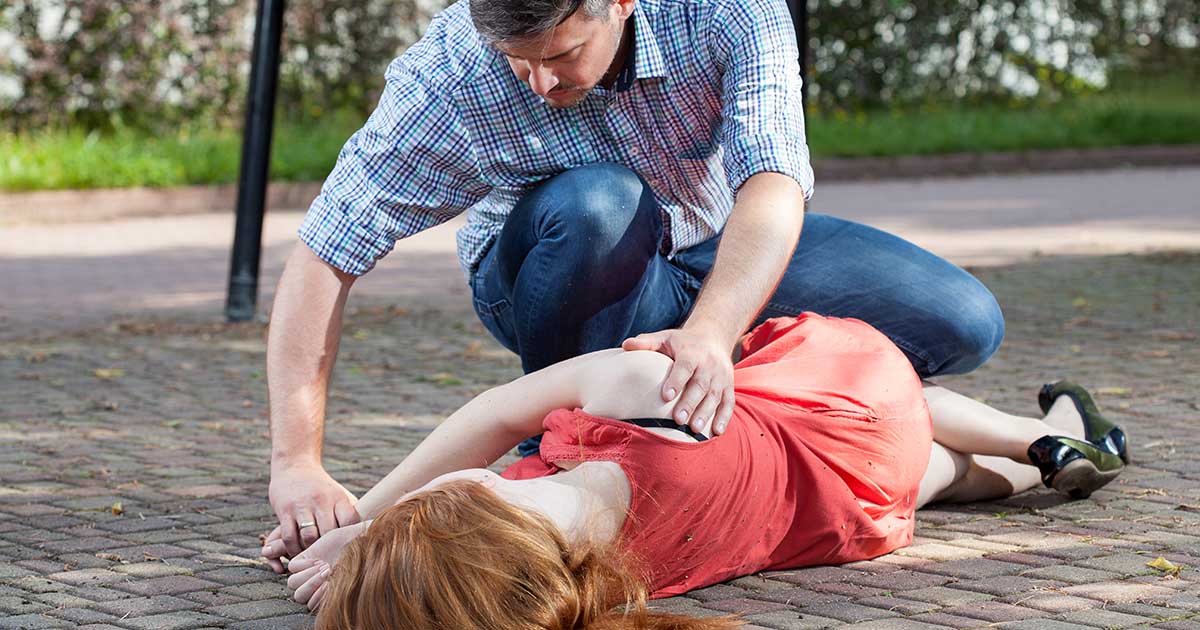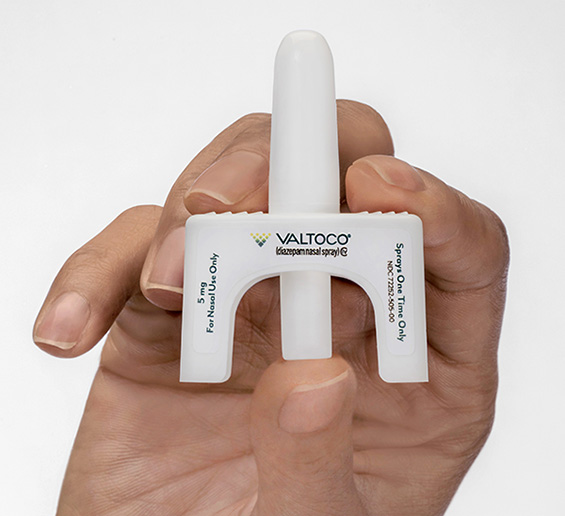Nasal Rescue Medicines

Nayzilam Nasal Spray
Midazolam nasal spray is commercially available under the brand name of Nayzilam®. For many years, doctors have prescribed compounding formulations of midazolam to use with a generic nasal atomizer. This branded form is more concentrated and easier to use.

Valtoco Nasal Spray
Valtoco® is the brand name for a nasal form of diazepam. This is the same medication used in a rectal form called Diastat.

Who can use nasal rescue medicines?
Both Naysilam and Valtoco have been approved by the U.S. Food and Drug Administration (FDA) for the acute treatment of intermittent, stereotypic episodes of frequent seizures. This is also known as seizure clusters or acute repetitive seizures that are distinct from a person’s usual seizure pattern.
- Most commonly, nasal rescue medicines are used in children or adults who are not able to take medicines by mouth or who find this way of giving medicine more helpful.
- Nasal rescue medicines work quicker than oral rescue medicines.
- Nasal rescue medicines are often a great alternative to rectal medicines.
- Nayzilam is approved for people age 12 years and older.
- Valtoco for people age 6 years and older.
Nasal rescue medicines should be used with caution by
- People with breathing problems, elderly people, or females who are pregnant, nursing, or planning to get pregnant.
Use and Dose
- Ask the prescribing doctor or nurse for specific instructions on when to use it and if a second dose of medicine should be used if seizures don't stop.
- Do not open individual blister packs or test the nasal spray devices before use.
- Each single-dose nasal spray device sprays 1 time and cannot be re-used.
- For Nayzilam, the starting dose is usually 5 mg given as a single spray into one nostril.
- For Valtoco, the dose depends on your age and weight. Make sure your treatment team knows if your (or your child’s) weight changes.
- When a 5 mg or 10 mg dose is prescribed, the nasal spray is given as a single spray into one nostril.
- For a 15 mg dose, two 7.5 mg nasal sprays are used, one sprayer in each nostril.
- For a 20 mg dose, two 10 mg nasal sprays are used, one sprayer in each nostril.
- If seizures don't stop or more seizures in a cluster happen, your provider may. recomment that a second dose is given.
- For Nayzilam, a second dose can be given 10 minutes or longer after the first dose if prescribed.
- For Valtoco, a second dose can be given at least 4 hours after the first dose if prescribed.
- Use the opposite nostril when a second dose is given
Important Points
- For Nayzilam, a second dose should not be given if there is concern about the person’s breathing or if they are very sleepy.
- Check with the prescribing provider about how often to use a nasal rescue spray. In general, Nayzilam is used for one seizure cluster every 3 days. Valtoco is used for 1 seizure cluster episode every 5 days. This may vary for each person so please check with your provider.
- Also, do not use nasal rescue medicines more than 5 times a month, unless directed by your prescribing health care provider.
Remember
- Check the prescribed dose with your pharmacist and review any questions with them.
- Do not open individual blister packs or test nasal spray devices before their use.
- Each single-dose nasal spray device sprays 1 time and cannot be re-used.
Packaging and Storage
- The medicines come prepackaged in single-dose nasal spray units.
- Nayzilam comes in a 5 mg nasal spray.
- Valtoco comes in 5 mg, 7.5 mg, and 10 mg nasal sprays. Valtoco dose is prescribed according to the age and body weight.
- Nasal rescue medicines do not need to be refrigerated, but keep it in a safe place, away from children.
- Make sure to check the expiration date and replace it if it has expired.
- After the nasal spray has been given, follow instructions on how to dispose of the nasal device.
How do you know if the proper dose has been set?
- When the prescription is picked up from the pharmacy, check to see if the prescribed dose is written on the box.
How is it given?
While some people may be able to give it to themselves, it may be easier to have someone else do it. Usually a parent, caregiver, or designated adult will give this nasal rescue medicine to a child.
Anyone who will be giving nasal rescue medicines should be taught how to use it properly by a doctor or nurse.
The following steps outline how to give nasal rescue medicines. Review these instructions with the prescribing health care provider and follow the package insert guidelines that come in the medication package.
- If the medicine is given during or after a seizure with loss of consciousness, turn the person on their side so they are facing you (or the person who will be giving it).
- If the person has had a focal seizure or the medicine is given after or between seizures, the person can be sitting in a comfortable position.
- Open the package and check the dose of the medicine with the prescription.
- Get the nasal spray device out of the blister pack.
- Hold the medication with your thumb on the bottom of the plunger and your first and middle fingers on either side of the nozzle.
- Do not press the plunger yet. If you press the plunger too early, you will lose the dose.
- Place the tip of the nozzle into 1 nostril until your fingers on either side of the nozzle touches the bottom of the nose.
- Press the bottom of the plunger firmly with your thumb to deliver the dose of nasal spray.
- Make sure to firmly press the plunger using 1 motion.
- Remove the nozzle from the nostril after giving the dose.
- Throw away the nasal spray unit and the empty blister package in the trash.
- Check on the person after the seizure and after the dose is given. Watch to make sure the seizure has stopped and no bothersome side effects occur.
For More Information
How long does it take to work?
Nasal rescue medicines are absorbed quickly from the nose. Seizures may stop within minutes of giving the medicine, but it will continue to work for much longer.
Follow instructions from your doctor carefully on how often a nasal rescue medication can be given.
- Since it can last a long time in the body, a second dose should be given only when it's prescribed for continued seizures.
- Make sure you know how often you can use this for cluster seizures. For example, can it be used every 3 or 5 days, or can it be used more or less often?
- Also ask how many times a month it can be used. If any rescue medicine is needed frequently, your provider may want to look at your whole treatment plan again with you.
Remember
- Nasal rescue medications should not be used instead of your daily regular medicines.
- Enter the information on your Seizure Action Plan.
What are common side effects of nasal rescue medicines?
- The most common side effect of these nasal rescue medicines reported during research studies was sleepiness and nasal discomfort. Since it is given after a seizure, it may be hard to tell if sleepiness is due to the seizure or the medicine.
- Less frequent side effects include headache, slurred speech, throat irritation, runny nose, abnormal taste, increased lacrimation, or nose bleeding.
- If side effects occur, talk to your doctor and nurse about what to do.
- If you develop a serious problem or have trouble tolerating it, you may be told not to use it again.
- If other minor side effects occur after using it, write down what happens and how you feel in a seizure diary to share with the doctor.
Remember
- Write down how you feel after using a nasal rescue medication.
- Call the doctor or get emergency medical attention if any serious problems occur after using a nasal rescue medication.
Is any special monitoring needed?
After a person has a cluster of seizures and is given a nasal rescue medicine, give the person a place to rest if possible and watch how they are doing for a period of time.
- Have someone stay with or check on the person for up to 4 hours after the nasal rescue medication is given to make sure the seizures have stopped. Also check that they are not having any changes in their breathing, skin color, or side effects.
- If the person is sleepy, let them rest for a while. When they are feeling back to normal, let them return to their usual activity.
- No special monitoring equipment is needed.
- Call for emergency medical help (usually 911) if:
- Seizure clusters are different and continue after the medicine is given.
- You are alarmed by how often the seizures happen, by how severe the seizure is, by how long the seizure lasts, or by the person’s color or breathing.
Resources
Epilepsy Centers
Epilepsy centers provide you with a team of specialists to help you diagnose your epilepsy and explore treatment options.
Epilepsy Medication
Find in-depth information on anti-seizure medications so you know what to ask your doctor.
Epilepsy and Seizures 24/7 Helpline
Call our Epilepsy and Seizures 24/7 Helpline and talk with an epilepsy information specialist or submit a question online.
Tools & Resources
Get information, tips, and more to help you manage your epilepsy.



